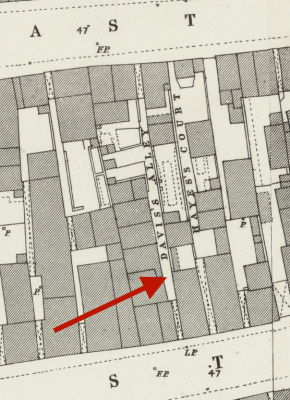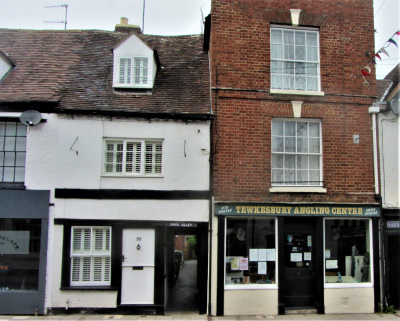Davis' Alley
The quiet equilibrium of the area was seriously disturbed in 1960. The Post Office was planning to move to a new building and discussion with the Borough Council had settled on all the land between Charlewood’s Alley and Davis’ Alley as suitable. Clearance Orders for the area were prepared, which included the cottages in the alley, but after four years negotiation the Post Office baulked at being involved in a compulsory purchase and pulled out of the deal. The Council thought this an important area for development, however, and pressed on with their plans to acquire it, demolish the existing buildings and manage its redevelopment.
Someone else had also been working on plans for the area. For many years, Sidney Hopton, who had a coal and haulage business in East Street, had been opportunistically buying up properties and leaving them empty when tenants left. He wasn’t at all happy with the compulsory purchase plan, and submitted his own application to extend his yard and to create a new row of shops in Barton Street. This conflict led to a planning enquiry, with Mr Hopton objecting to the compulsory purchase of his property and promoting his own plans. The inspector found for the Council, who compulsorily purchased all the Barton Street properties which were emptied. In the absence of a deal with the Post Office, they eventually agreed to sell the site to the County Council for a new Police Station. This had no effect on Davis Alley, though, as the Police Station didn’t need the demolition of 29 and 30 Barton Street. The two Davis’ Alley cottages owned by the Borough Council, numbers 1 and 2, were also spared demolition and were eventually incorporated into the restaurant at No 29, now the ‘Balti Palace’
Mr Hopton resorted to a smaller plan, demolishing the houses he owned in Davis’ Alley, numbers 3 and 4, in order to extend his yard, building new garaging and warehousing off East Street. This, unsurprisingly, led to strong complaints about noise and disturbance. Because of the rapid changes in the size of lorries and the sale of his coal merchant business the venture was quite short-lived. In about 1990 the yard was replaced by a housing development, named Hopton Court, remembering the previous occupiers of the site.
The Hopton Court buildings follow the line of the alley, though with a very different architectural style to their predecessors, bringing people and life back and creating a hybrid alley, with an harmonious mix of old and new. If only there were a solution to the storage of wheelie bins, though!
to Expand
Writing in 1905, Alley historian John Rogers, said of this Barton Street (north side) alley: ‘Named after Mr George Davis who owned the front street house on the right-hand side of the alley. He was highly respected and ranked amongst the well-to-do inhabitants of the town. He was a pig dealer and bacon curer. He sold black puddings, bacon and chitterlings. In those old times almost everyone had a nickname and Mr Davies was called ‘Chitterlings George’. Chitterlings were the food of the very poor, effectively sausages without the filling. George Davis had died in December 1845, aged 79, when John Rogers was 37.
The naming of the alley breaks the rule that alleys are named after their front house, because the alley is not behind the house on the right-hand side, it’s behind No 30, on the left-hand side, a smaller building and probably with a less colourful resident.
The 1841 census shows thirteen cottages in this small alley, with almost fifty residents. By 1861, there were just six occupied cottages and John Rogers reports four in 1905. The buildings may have been put to other uses, of course but some could have been demolished. In an auction in 1861, a cottage with garden in Davis’ Alley was sold to Mr Pitman for £80. In the same sale a cottage in Double Alley sold for £21. A considerable difference! A similarly-described cottage sold in 1881 had a shed and WC in its garden. A far higher standard than was the norm in alleys. There were small, ‘one up, one down’ cottages as well, though. In 1882, the Medical Officer of Health was involved in rehousing a family with nine children who were living in very cramped conditions in a very small cottage.
Life in the alley seemed to be generally harmonious. There was the occasional ripple; the deaths, births and weddings which punctuate life. In 1922, Mable Jordan divorced a husband who had left her after three days and been convicted of bigamously marrying Ethel Brown in Gloucester.




Comments